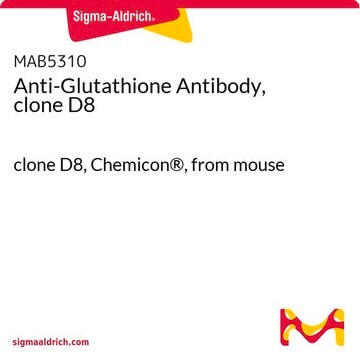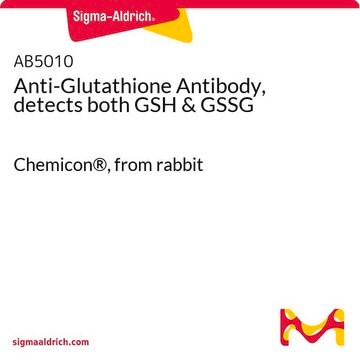MAB3194
Anti-Glutathione: N-ethylmaleimide adduct Antibody, clone 8.1GSH
clone 8.1GSH, Chemicon®, from mouse
About This Item
Productos recomendados
biological source
mouse
Quality Level
antibody form
purified antibody
antibody product type
primary antibodies
clone
8.1GSH, monoclonal
species reactivity (predicted by homology)
mammals
manufacturer/tradename
Chemicon®
technique(s)
ELISA: suitable
flow cytometry: suitable
immunocytochemistry: suitable
immunohistochemistry: suitable
western blot: suitable
isotype
IgG1
shipped in
wet ice
target post-translational modification
unmodified
Specificity
Immunogen
Application
Immunocytochemistry: 1:100 - 1:500 for assessment of intracellular GSH distribution.
ELISA: 1:100,000 - 1:200,000 to quantify GSH at >2 mM in biological specimens.
Flow cytometry: 1:100 - 1:1,000
Cells were fixed with cold 1% PFA for 5 min and vortexed into methanol (-20°C) containing 5mM NEM (10 min on dry ice) or 10 μM NEM (N-ethyl maleimide) for 30 min at RT.
Optimal working dilutions must be determined by end user.
Positive Control: Peripheral blood mononuclear cells (PBMC) treated with NEM
Neuroscience
Oxidative Stress
Physical form
Storage and Stability
Other Notes
Legal Information
Disclaimer
Not finding the right product?
Try our Herramienta de selección de productos.
Storage Class
10 - Combustible liquids
wgk_germany
WGK 2
flash_point_f
Not applicable
flash_point_c
Not applicable
Certificados de análisis (COA)
Busque Certificados de análisis (COA) introduciendo el número de lote del producto. Los números de lote se encuentran en la etiqueta del producto después de las palabras «Lot» o «Batch»
¿Ya tiene este producto?
Encuentre la documentación para los productos que ha comprado recientemente en la Biblioteca de documentos.
Nuestro equipo de científicos tiene experiencia en todas las áreas de investigación: Ciencias de la vida, Ciencia de los materiales, Síntesis química, Cromatografía, Analítica y muchas otras.
Póngase en contacto con el Servicio técnico






